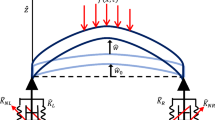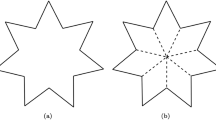Abstract
A newly developed dissipative family method is adopted and implemented for pseudodynamic tests in this investigation since it can have desired numerical properties. In fact, it can integrate unconditional stability, second-order accuracy and favorable numerical dissipation together. In addition, its pseudo-dynamic implementation involves no iteration procedure for each time step due to the explicitness of each time step. Hence, this pseudodynamic algorithm is promising for solving an inertial problem, where the total response is dominated by low frequency modes and the high frequency responses are of no interest. Currently, there is no pseudodynamic algorithm can have such desired numerical properties for practical applications. In addition to the application to a general pseudodynamic test, it might enable the ability to conduct a real-time substructure test for a large degree of freedom system due to its computational efficiency.
















Similar content being viewed by others
References
Takanashi K, Udagawa K, Seki M, Okada T, Tanaka H (1975) Nonlinear earthquake response analysis of structures by a computer-actuator on-line system. Bulletin of Earthquake Resistant Structure Research Center, University of Tokyo, Japan, 8
Mahin SA, Shing PB (1985) Pseudodynamic method for seismic testing. J Struct Eng ASCE 111(7):1482–1503
Shing PB, Mahin SA (1987) Cumulative experimental errors in pseudodynamic tests. Earthq Eng Struct Dyn 15:409–424
Shing PB, Mahin SA (1990) Experimental error effects in pseudodynamic testing. J Eng Mech (ASCE) 116:805–821
Peek R, Yi WH (1990) Error analysis for pseudodynamic test method. I: Analysis. J Eng Mech (ASCE) 116:1618–1637
Chang SY (2000) Error propagation effects for explicit pseudodynamic algorithms. Struct Eng Mech An Int J 10(2):157–164
Shing PB, Manivannan T (1990) On the accuracy of an implicit algorithm for pseudodynamic tests. Earthq Eng Struct Dyn 19:631-651
Chang SY (2003) Nonlinear error propagation analysis for explicit pseudodynamic algorithm. J Eng Mech (ASCE) 129(8):841–850
Chang SY (2005) Error propagation in implicit pseudodynamic testing of nonlinear systems. J Eng Mech (ASCE) 131(12):1257–1269
Shing PB, Mahin SA (1987) Elimination of spurious higher-mode response in pseudodynamic tests. Earthq Eng Struct Dyn 15:425–445
Chang SY (1997) Improved numerical dissipation for explicit methods in pseudodynamic tests. Earthq Eng Struct Dyn 26:917–929
Nakashima M, Masaoka N (1999) Real-time on-line test for MDOF systems. Earthq Eng Struct Dyn 28:393–420
Wu B, Bao H, Ou J, Tian S (2005) Stability and accuracy of the central difference method for real-time substructure testing. Earthq Eng Struct Dyn 34:705–718
Zhang YF, Sause R, Ricles JM, Naito CJ (2005) Modified predictor-corrector numerical scheme for real-time pseudodynamic tests using state-space formulation. Earthq Eng Struct Dyn 34:271–288
Alamatian J (2013) New implicit higher order time integration for dynamic analysis. Struct Eng Mech An Int J 48(5)
Nakashima M, Kaminosomo T, Ishida M (1990) Integration techniques for substructure pseudo- dynamic test. Proc Fourth US Ntnl Conf Earthq Eng 2:515–524
Shing PB, Vannan MT, Carter E (1991) Implicit time integration for pseudodynamic tests. Earthq Eng Struct Dyn 20:551–576
Chang SY, Mahin SA (1993) Two new implicit algorithms of pseudodynamic test methods. J Chin Inst Eng 16(5):651–664
Thewalt CR, Mahin SA (1995) An unconditionally stable hybrid pseudodynamic algorithm. Earthq Eng Struct Dyn 24:723–731
Wu B, Wang Q, Shing PB, Ou J (2007) Equivalent force control method for generalized real-time substructure testing with implicit integration. Earthq Eng Struct Dyn 36(9):1127–1149
Wang Z. Wu B. Bursi OS. Xu G. and Ding Y (2014) An effective online delay estimation method based on a simplified physical system model for real-time hybrid simulation. Smart Struct Syst An Int J 14(6)
Verma M, Rajasankar J, Nagesh RI (2015) Numerical assessment of step-by-step integration methods in the paradigm of real-time hybrid testing. Earthquakes Struct An Int J 8(6)
Newmark NM (1959) A method of computation for structural dynamics. J Eng Mech Div (ASCE) 85:67–94
Hilber HM, Hughes TJR, Taylor RL (1977) Improved numerical dissipation for time integration algorithms in structural mechanics. Earthq Eng Struct Dyn 5:283–292
Combescure D, Pegon P (1997) Alpha-operator splitting time integration technique for pseudodynamic testing - Error propagation analysis. Soil Dyn Earthq Eng 16(7–8):427–443
Chang SY (2002) Explicit pseudodynamic algorithm with unconditional stability. J Eng Mech 128(9):935–947
Chang SY (2004) Unconditional stability for explicit pseudodynamic testing. Struct Eng Mech An Int J 18(4):411–428
Chen C, Ricles JM (2012) Analysis of implicit HHT-α integration algorithm for real-time hybrid simulation. Earthq Eng Struct Dyn 41:1021–1041
Chang SY (2010) Explicit pseudodynamic algorithm with improved stability properties. J Eng Mech, ASCE 136(5):599–612
Chang SY (2013) An explicit structure-dependent algorithm for pseudodynamic testing. Eng Struct 46:511–525
Chang SY (2014) A family of non-iterative integration methods with desired numerical dissipation. Int J Numer Methods Eng 100(1):62–86
Chang SY (2015) A general technique to improve stability property for a structure-dependent integration method. Int J Numer Methods Eng 101(9):653–669
Belytschko T, Hughes TJR (1983) Computational Methods for Transient Analysis. Elsevier Science Publishers B.V., North-Holland
Acknowledgments
The authors are grateful to acknowledge that this study is financially supported by the National Science Council, Taiwan, R.O.C., under Grant No. NSC-100-2221-E-027-062.
Author information
Authors and Affiliations
Corresponding author
Rights and permissions
About this article
Cite this article
Chang, SY., Wu, TH., Tran, NC. et al. Applications of a Family of Unconditionally Stable, Dissipative, Explicit Methods to Pseudodynamic Tests. Exp Tech 41, 19–36 (2017). https://doi.org/10.1007/s40799-016-0151-4
Received:
Accepted:
Published:
Issue Date:
DOI: https://doi.org/10.1007/s40799-016-0151-4




